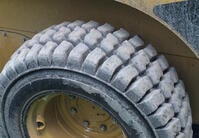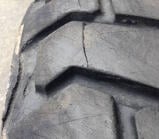Where Skid Steers Wear Tires
At a quick glance, many skid steer tire tread patterns can look similar. But when you look closer, you can spot differences that can have a huge impact on your productivity—and your bottom line.
Compare the tires in these photos. The Galaxy Trac Star on the left and a competitor tire on the right:


Look at the shoulders of the tires. The competitive tires’ shoulders are cut and scuffed—in some places, all the way down to the inner layers of the carcass. That’s a tire that is about to put that machine out of business, maybe for hours.
The problem is that half the lugs don’t reach all the way to the shoulder of the tire, leaving 50% of the tire’s edge vulnerable to severe damage, especially in the tough conditions in which many skid steers operate.
Now look at the Galaxy Trac Star, which is available in the 12x16.5 tire size and other popular sizes. It’s exhibiting significant tread wear, which is no surprise—this was taken during an accelerated wear field trial on a repaving job. But look at how consistent the wear is. The footprint of the tire is still broad and even. The rugged tread compound has resisted cuts and chips. And unlike the competition, the shoulders of the tires are safe and sound, thanks to strong tread blocks that all reach to the shoulder, all the way around the tire.
Another thing that shouldn’t surprise you—in that accelerated wear test, the Galaxy Trac Star lasted 21% longer than one competitor and 140% longer than another.
A lot of things go into a tire. We pay careful attention to all of them—top to bottom, and shoulder to shoulder -- in our Galaxy industrial tires, as well as our Alliance agricultural tires and Primex forestry tires.
If you utililze skid steer tires in your business, we would love to hear about your experiences.


